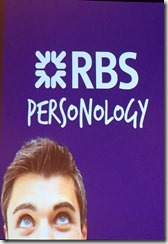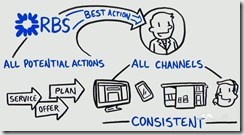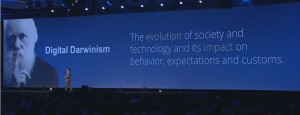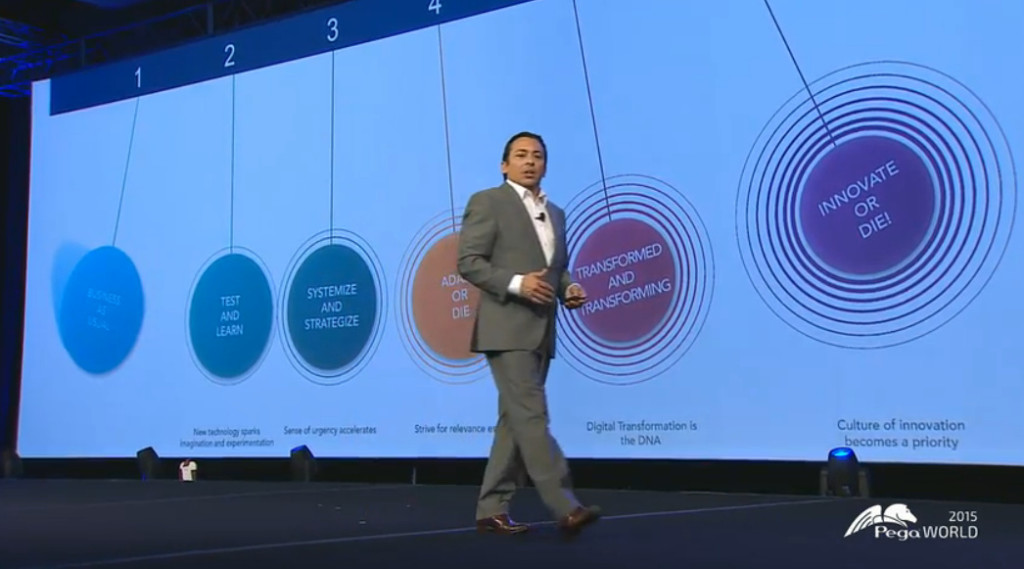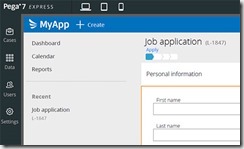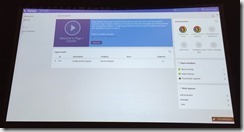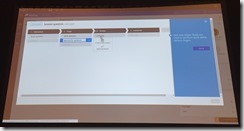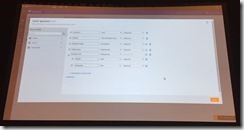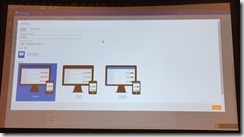Orlando in June? Check. Overloaded wifi? Check. Loud live band at 8am? Check. I must be at PegaWORLD 2015!
Alan Trefler kicked off the first day (after the band) by looking at the new world of customer engagement, and how both organizations and the supporting technology need to change to support this. He took a direct hit at the silos of old-school companies such as traditional financial services (“What *is* a middle office, anyway?”, a question that I’ve often asked), and how many applications and platforms fail to move them beyond that model: conforming (to how an application works out of the box) versus strategic (mix your own DNA into the software). Like many other vendors in this space who are repositioning as process-centric application development platforms, the term BPM (business process management) didn’t come up; Pega is repositioning as “CRM Evolved”. To be fair, Pega has always had a strong CRM (customer relationship management) bias, but it looks like they’re rebranding the entire business of their customers as CRM, from sales and onboarding through support and back into operations. This includes anticipating and operationalizing customer actions, so that you can respond to a potential problem before it ever occurs, and moving from conforming to strategic software in order to allow you to evolve quickly to meet those needs. He warned against implementing the Frankenstack, pieced together from “dead software products”, and decried the term BPM in favor of case management as how customer engagement and operations need to work, although arguably there is a lot of what we think of a traditional BPM implemented as part of Pega’s customers’ solutions.
We’re definitely seeing the BPM market (broadly defined to include dynamic and ad hoc process management including case management) bifurcating into the application development platforms such as Pega, and the more out-of-the-box, low-code process platforms. BPM is really much beyond just process management, of course: many of these platforms include mobile, social, IoT, analytics, big data and all of the other popular features that are being built into almost all enterprise applications. Trefler talked about Pega 7 Express – I’ll be going to a session on that after the keynote – which is a simpler user experience for application development. Having seen their more complex user experience in a few client projects, this is definitely needed to cut through the complexity in order to address the end-user computing/citizen computing needs. In other words, although they are primarily in the heavy-duty application development space, they also realize that they can’t ignore the “low end” of the market if they want to achieve greater awareness and penetration in their customer environments beyond the IT development group.
Trefler also talked about Pega’s vertical industry applications, and we heard from Dr. Mark Boxer from Cigna Healthcare. He discussed how they use Pega’s Smart Claims App, although we mostly saw a lot of futuristic videos of what healthcare could be like, including big data and gamification. Plus Apollo 13. It’s not clear how much of this that Cigna has implemented (presumably they are not working on the moon shot) although I know that some US healthcare companies are reducing premiums for customers who use wearables to monitor their health since it allows for early problem detection.
Don Schuerman, Pega’s CTO and VP of Product Marketing, took the stage to talk about their technology, with a big focus on strategic applications rather than the platform itself – Trefler did make a comment earlier about how their marketing used to be really bad, and I think that someone told them that applications show better than platforms – plus their cloud infrastructure. He was joined by Jim Smith, CIO of the State of Maine, who was not afraid to talk about BPM: he sees BPM plus agile plus legacy system modernization as the cornerstones of their enterprise strategy, underpinned by a cloud platform for speed and security. He showed some pictures of their filing cabinets, pending files in paper folders and other paper-based inefficiencies; it’s interesting to see that there is still so much of their digital transformation – and that of many other organizations that I work with – that is relying on getting paper into digital form, either natively (i.e., online forms replacing paper ones) or through image and data capture.
Brian Matsubara, head of Global Technology Alliances at Amazon, talked briefly about their Amazon Web Services offerings, and their partnership with Pega to create the Pega Cloud on which Pega 7 Express and other products are domiciled. I don’t need to be sold on cloud in general or AWS in particular since I trust critical business data to AWS, but there are still a lot of skittish organizations who think that their own data centers are better, faster, cheaper and more secure than AWS. (Hint: they’re not.) I just finished up the materials for a workshop that I’m giving in London next week on the Future of Work, and I agree with what Matsubara said about (public) cloud: it’s not just cheaper infrastructure, it provides ways of doing business that just weren’t possible before, especially consumer mobile and external collaboration applications. Schuerman stressed at the end that they need to help their customers make cloud strategic:
The keynote finished with Kerim Akgonul, SVP of Products, who discussed changing customer attitudes: customers now expect more, and will quickly make their displeasure public when the experience is less than awesome. He talked about their suite of applications – Marketing, Sales Automation, Customer Service, and Operations – and how decision-based Next Best Action predictions and recommendations are an underlying feature that drives all of them. The Pega Marketing application brings tools to help improve customer engagement, including next best action and 1:1 targeted marketing. Their Sales Automation application offers guided selling through the end-to-end sales process. Their Customer Service application uses case management paradigms and next best actions for guided customer conversations, while interacting with social media and other channels. Akgonul is always willing to participate in the on-stage highjinks: last year, it was a wild motorcycle ride, and this year it’s a wellness app on an iWatch and iPhone that tied in with a customer service agent’s screen, with some assistance from his colleagues David Wells and Don Schuerman. Fun, and drove home the point about how these technologies can be used to improve customer engagement: mobile, omni-channel, next best action, gamification and more. He wrapped up with a more serious, if somewhat breathless, look at some of the newer features, including offline mobile apps that can synchronize data later, pattern detection in real-time streaming data such as dropped calls, dashboard personalization, and the new Pega 7 Express lightweight application builder.

